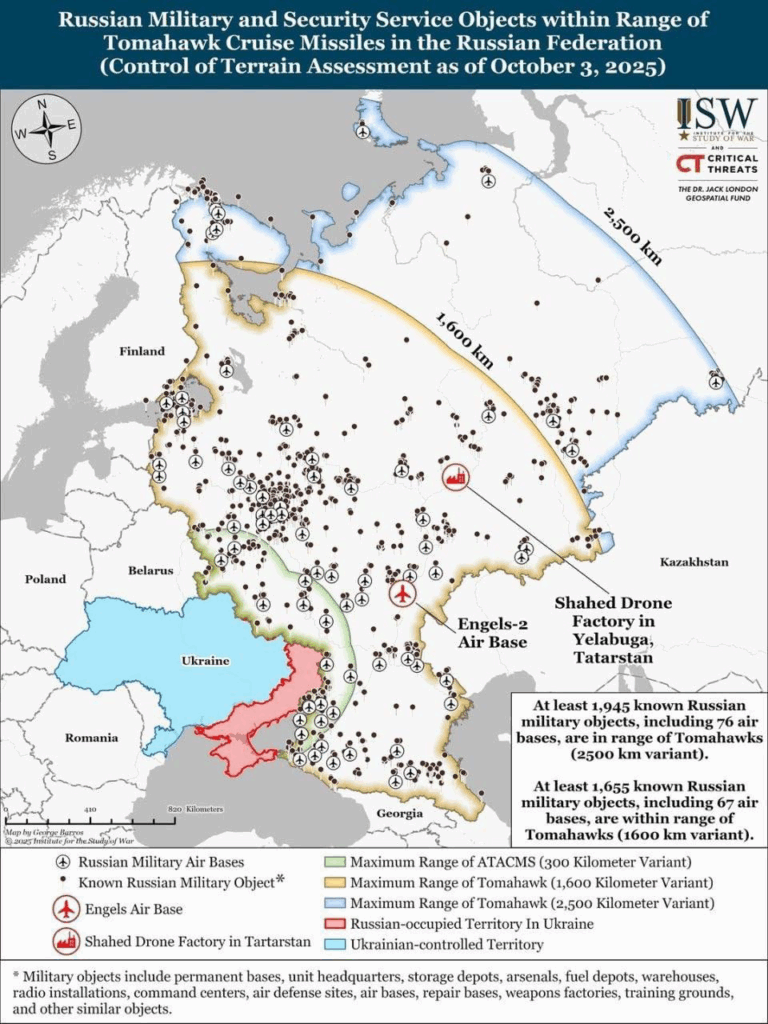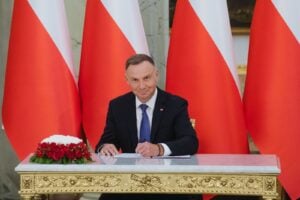“Strike” on Putin’s birthday: Tomahawk is on its way to Ukraine – expert
7 October 17:25
Even a few launches of Tomahawk cruise missiles could change the balance of power in the war and jeopardize key Russian infrastructure. Military experts warn that their unique characteristics make the missiles virtually invulnerable to air defense, and potential strikes on the Kremlin’s refineries and logistics hubs could be a strategic shock.
Meanwhile, U.S. policymakers are playing a cautious game, trying to combine support for Ukraine with avoiding direct escalation. However, Trump’s words about the possible transfer of Tomahawk missiles to Ukraine have already caused Russian propaganda to panic, threatening nuclear strikes. What did Donald Trump actually say and can his words be interpreted as a decision? Does this mean that the Tomahawk transfer process has already begun? How these missiles can change the course of the war and cause strategic damage to Russia’s infrastructure – in the article
What did Trump really say?
The morning of October 7 began with a real information explosion – the world media started talking about Donald Trump’s “consent” to the transfer of Tomahawk missiles to Ukraine. However, when asked by a journalist whether Trump had decided to send Tomahawk missiles to Ukraine or to sell them to NATO and allow them to transfer them to Ukraine, the US president answered in his typical style – in a multi-valued way, with hints and deviations from the direct thesis.
“Yeah, I’ve kind of made a decision, actually, when you think about it. I guess I want to find out what they’re going to do with them-where they’re going to send them, I guess. I would have to ask that question. But the war should never have started… No one looks good in this war between Russia and Ukraine – no one” – Donald Trump
When the journalist clarified that Tomahawks have a range of approximately 1500 miles, Trump immediately added:
“No, I know. No, I want to… I would ask a few questions. I want to see what… I don’t want to escalate,” Trump added.
That is, despite the sensational headlines, Trump did not actually confirm the transfer of missiles to Ukraine. Rather, he made it clear that the issue has not yet been resolved and will depend on further circumstances.
It is ironic that these words came on October 7, Putin’s birthday. A symbolic coincidence that can hardly be called pleasant for the Kremlin.
The process of Tomahawk transfer has begun – Professor
Donald Trump’s decision to transfer Tomahawk missiles to Ukraine is on the table. Sergiy Yagodzinsky, Doctor of Philosophy, Professor, Vice-Rector of the European University, in an exclusive commentary
“Well, indeed, the issue of Tomahawk missiles has been discussed in the information space of Ukraine for a long time. And today Trump seems to be giving his consent. We understand that when the top US official gives his approval, it is actually the start of the process of transferring some arsenal,” Professor Yahodzinsky said.
At the same time, according to Yahodzinsky, Trump’s rhetoric about “slowing down” the process is more symbolic and is related to the US’s fears of Moscow’s reaction.
“Trump’s rhetoric about a certain slowdown in the start of the transfer is only related to the insurance of the United States of America in the face of the Russian Federation. It is important for the United States to have a certain piece of paper that says that America is transferring such warheads on the condition that Ukraine will use them for certain purposes and not for some,” says Serhiy Yahodzinsky.
The professor emphasizes that it is important for Trump to have political cover, especially if the missiles are used against sensitive targets in Russia.
Will Tomahawks change the course of the war?
The US transfer of Tomahawk cruise missiles to Ukraine could be a turning point in the war. Military expert Dmytro Snegirev explained why these missiles are critically dangerous for Russia and why their appearance in the armament of the allies causes panic in Moscow.
“The Russian army has no analogues to the Tomahawk missile. The missile has a range of 1500 km and a warhead of 500 kg. But the main thing is that it can fly at ultra-low altitudes, taking into account the terrain. That is, in fact, outside the area of air defense systems. This is the main danger of these missiles,” Snegiryov emphasized.
According to the expert, this characteristic makes the Tomahawk a unique weapon capable of hitting targets far beyond the front line, including oil refineries, logistics hubs and facilities of the Russian military-industrial complex.
A few launches are enough to make Russia forget about its refineries. Snegiryov cites specific calculations and comparisons with previous attacks by Ukrainian drones, which have already caused serious damage to Russian infrastructure.
“To understand the situation, even the use of drones with a warhead of up to 120 kilograms was able to neutralize up to 38% of Russian refineries. They either partially or completely stopped working. And here it is said that the warhead is many times larger and, accordingly, the damage capabilities and consequences for the refinery will be critical,” explained Dmitry Snegirev.
He emphasizes that even a few accurate launches can cause strategic damage to the Russian economy:
“A few launches are enough to make the Russian Federation forget about the existence of oil refineries on its own territory. It is worth mentioning that there are not so many of them, all refineries. And given that the lion’s share of them are already out of commission, this explains why the Russians started to panic,” Snegirev says
Where can Tomahawks fly to?
A map of the Tomahawk cruise missile range shows that the area up to 1600 km covers the Ural region, including the Perm Territory and the Komi Republic, while the maximum range of about 2500 km allows the missile to hit targets much further into Russia: Yekaterinburg, Tyumen, Chelyabinsk, and part of the Khanty-Mansi Autonomous Okrug.
There are often claims that Tomahawk missiles are used exclusively from ships or submarines. Dmitry Snegirev refutes this myth.
“Numerous experts have emphasized that Tomahawk is a sea-based missile. The US has a ground-based component in service, the so-called Typhon. There are a really limited number of them, but the very fact of the transfer of Tomahawk, even one launcher, will be a political and military signal for the Russian Federation,” noted Dmytro Snegiryov

Reaction of propagandists to Tomahawk
“They will strike Paris, Berlin, Warsaw” – propagandists reacted to Trump’ swords about Tomahawkswith hysteria, and then, as usual, with threats of nuclear weapons.
- Medvedev is in his usual style again. Dmitry Medvedev, Deputy Chairman of the Security Council, was one of the first to react. He said he knew where the missiles would be aimed.
“It’s obvious: they will hit Paris, Berlin, Warsaw. Even the President of the United States should understand this…” – Medvedev
- Telegram channels added fuel to the fire
Anonymous telegram channels close to Russian law enforcement agencies did everything they could to stir up panic. We are sure that the old Western scheme of saying that if Russia does not make concessions, the weapons will be transferred to Ukraine, but in fact, they are already preparing personnel and sending these weapons. The channel’s authors even hinted that “Tomahawks may already be in Ukraine” and warned.

“If the first launches take place before a year of training, it will mean the direct involvement of NATO troops in strikes against Russia.” – “Two Majors“
- Even more aggressive was the reaction of theThirteen channel, which, after publishing a photo of nuclear weapons, called Trump “an enemyblusterer ” and threatened that if Ukraine received the missiles, it would “consider the Kremlin a target for attack.”
“Aren’t the Rada and the Pentagon worried about anything?” the Thirteenauthors sarcastically concluded their post .
The hysteria in the Russian information space looks like a classic information operation, with overstated threats, distorted quotes, and fears of “escalation“ from the West. In Moscow, these words seem to have been interpreted in a way that suited them and turned into yet another reason to shout about the “threat to Russia’s existence.”









